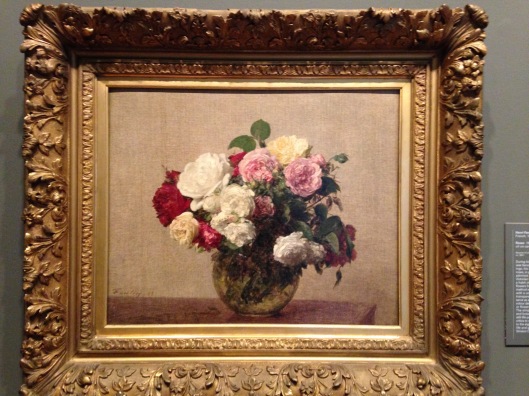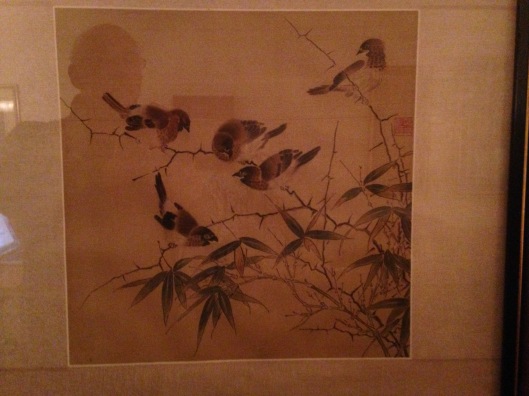Tags
BMAC, Canada., China, docent, Europe, Fantin-Latour, museum, NGC, Ottawa, painting, Renaissance, Song Dynasty, Zhai Wei
This week I had 3 days of duty as docent at the National Gallery of Canada. One was hosting the Wednesday Morning Lectures-Mercredis Culturels, I coordinate that program in French and in English. Then I had a school group, the students around 9 years of age where quite good and had lots of good questions and observations, the teacher was also interested and helpful, that is not always the case. We also had a training session, unfortunately the NGC is under a lot of renovations in preparation for Canada’s 150th Anniversary of Confederation. The Canadian Galleries are being completely redone, the Bookstore is getting a facelift after 27 years in the same spot. There is also some work installations in the Contemporary Galleries which are taking more and more space at the NGC and slowly eclipsing the other collections. Also all the lights in the museum are being converted to LED, apparently that is better. I also presented a work of art by Matthias Stom, Flemish School of Painting, 1630, entitled The arrest of Christ. I never know who is going to come and listen to my presentation which last about 10 minutes,”officially”. I had a father with his little daughter who was 7 yrs old and she wanted to know what a Museum guide did, she was very attentive and a little overwhelmed. I also had a couple from Spain and a Muslim lady who told me how much she loved the museum and was appreciative of my presentation. Another lady wanted to give me a tip, which I declined.

The subject of this painting from the Baroque period is religious and so I was not sure how it would go over. You cannot count on people knowing about Biblical stories or even being able to identify the Deity nowadays. At any rate I concentrate on the colours, the light and other details of the composition such as facial expression, clothing, hand gestures etc. I speak about the painter and the technique he used and then speak about the frame and how it was made. One person did ask me where this scene was taking place and another asked who was Judas. Christ is looking up towards Heaven and one person asked what is he looking at given the violence around him, I said God the Father which confused them, many do not know who that is. A bit like in another tableau where the Virgin Mary and Jesus are featured, many Renaissance paintings (1300-1600) have a strong religious subject. One fellow asked me who was that women with the baby in her arms, before I had time to answer a 9 year old who was also looking at the painting said, that’s Mary and Jesus, thank you kid and shame on the adult.

Virgin and Child with St-Anthony Abbot by Hans Memling
I take that sort of lack of knowledge as a sign of the age we live in, we think we know a lot but in fact we know nothing and understand even less. To me that is really sad and unfortunate. Quite a few people do not understand why European paintings of the Renaissance and Baroque period feature religious themes, despite the fact that the explanation fact sheet explains where it came from. There appears to be this belief that since we all know religion is bunk then why show it, it’s boring I am told. Sad really, I often have to explain that the European galleries show 900 years of paintings and through the ages style and fashion evolve and we are showing this evolution in human history. The galleries are arranged like a clock when you start you are in 1290 and when you finish at the other end its 1970, still many just don’t get it. Well I console myself, thinking if one visitor I spoke too loved it and was inspired my job is done.

I wonder if anyone has done a study of why more women come to the museum than men. I am sure there must be a thesis some where on the topic. I did observe that in Europe there are more men in Museums in general but in North America it is different, culture no doubt.
Finally, I always make a point of going through the galleries whenever I have a moment at the museum to look at what is new. In the last week I counted 15 new works on the wall. They had replaced other works, so the rotation happens more quickly now than before, the NGC can only show about 1000 works at the moment with the space we have, the basement has over 35,000 in storage. This of course is not counting the sculptures, the Diploma works of the Canadian Royal Academy, the photographies and all the sketches and prints. We do have a very rich collection.
While I was walking in the 19th century gallery, a work by Henri Fantin-Latour (1836-1904) caught my eye, entitled Roses, 1885. The simplicity of presentation and botanical accuracy of his still-life paintings prompted many critics to compare him to the 18th century painter Jean-Siméon Chardin.
What I did not know and discovered was that Fantin-Latour would pick flowers from his own garden early in the morning, arrange them and then create a painting of them. He became famous for his delicate portrayal of roses.

Les Roses, 1885 at the National Gallery of Canada.
I also noticed on the explication note that he would cover the canvas with a thin layer of transparent colour that would serve as a background- a neutral colour determined by the bouquet he wanted to paint.
During the Song Dynasty in China (960-1127) painters would do this also on their canvas applying a thin layer, with a broad brush, of black tea and ink.

Unfortunately the reflection of the glass does not help, however I purchased this in Beijing from an artist of the Chinese Central Academy of Arts, Ms. Zhai Wei. She applied a thin layer of black tea and ink before painting the little sparrows on a ficus branch, thus imitating the style of painters during the Song Dynasty.

i’ve always found something special about Fantin-Latour’s flower paintings.
On punter ignorance, when I gave guided tours round the Freud Museum in Hampstead, an American gentleman asked me if Freud and Mozart ever met.
LikeLike
I think they went to school together. LOL! There should be a compilation of silly questions, it would make for fun reading.
LikeLike
You’ve been busy. The light in the first painting is beautiful I think. By the way we share the same taste in spectacles. They look better on you.
JP
LikeLike
thanks, but I do not wear them often, I have another pair, different model which I wear all the time. I always am busy, I forgot to mention I am also coordinating our house move which is coming up in 3 months time with all the logistics that implies.
LikeLike
My favourite work of art in this post is the portrait between the “Virgin and Child” and the still life.
LikeLike
thank you!
LikeLike
A lovely virtual tour. Thank you so much.
LikeLike
You are welcome.
LikeLike
I loved the tour..I find that I enjoy the painting how’s as much as the subject..I may not believe in what the paintings are, but the work is wonderful..the roses are incredible..I know a little about a lot of things..which I think is important..I’m always giving the girls little bits of knowledge..stuff I know they know nothing about..they think I’m a genius..haha
LikeLiked by 1 person
Jackiesue you make an interesting comment, when you say ”I may not believe in what the paintings are” I do encounter quite a few visitors who say this and I always what to ask them what is it that make you doubt what you are looking at. Some will give a vague answers others will say that they think the painters made the topic up. Given that paintings are between 100 to 400 years old, the artists lived in a very different world than ours. Can you tell me what makes you say that?
LikeLike
“I coordinate that program in French and in English.”
When we were touring the National Archaeological Museum in Athens, I ‘confronted’ a guard about why his admonishments to visitors about ‘too close to the objects’, or ‘no photographs’, were always offered in English! He did get my meaning and looked smilingly embarrassed;-)
LikeLike
I have to say that I do not quite understand the policies, plural, of various museum. Per example at the Hermitage the director does not care if you take a picture or not. But he is very strict about not touching anything. At our NGC, the policy is no pictures for certain paintings and it is ok to take pictures of other paintings just no flash. No touching applies. It is very confusing for most people, few understand or respect the no photo policy. It comes from an age of ignorance and too much Wikipedia. There is also a fundamental lack of respect for anything. Are we going back into a new Dark Age, I think so.
LikeLike
I suspect a person could reach a saturation point where just one more really ignorant question could make him drop his baton and walk off stage! From your accounts, however, you appear endlessly tolerant. (Not surprising.)
LikeLike
We are trained to expect the worst and always try to answer politely, no matter how silly the question may be. Never walk away the Boetian must be tolerated.
LikeLike
Great post. I love the Fantin-Latour!
LikeLiked by 1 person
I suspect in the Western world going to the museum is another matter as ‘feminine’ as real men don’t do such things/
LikeLike
Indeed a North American thing, not so prevalent in Europe.
LikeLike